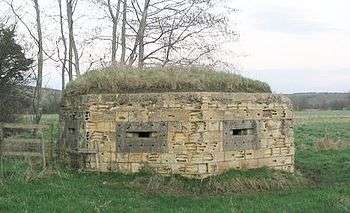Pillbox (military)

Pillboxes are concrete dug-in guard posts, normally equipped with loopholes through which to fire weapons. The originally jocular name arose from their perceived similarity to the cylindrical and hexagonal boxes in which medical pills were once sold.[1] They are in effect a trench firing step hardened to protect against small-arms fire and grenades and raised to improve the field of fire.
Description
The concrete nature of pillboxes means that they are a feature of prepared positions. They were probably first used in the Hindenburg Line. This is likely to have been the time when they acquired their incongruous English name. The Oxford English Dictionary's earliest record of the use of the word pillbox in connection with a defensive post is from 13 September 1917, after the German withdrawal onto the Hindenburg Line.[2]
Some pillboxes were designed to be prefabricated and transported to their location for assembly. During World War I, Sir Ernest William Moir produced a design for concrete machine-gun pillboxes[3] constructed from a system of interlocking precast concrete blocks, with a steel roof. Around 1500 Moir pillboxes were eventually produced (with blocks cast at Richborough in Kent) and sent to the Western Front in 1918.[4][5]
Pillboxes are often camouflaged in order to conceal their location and to maximize the element of surprise. They may be part of a trench system, form an interlocking line of defence with other pillboxes by providing covering fire to each other (defence in depth), or they may be placed to guard strategic structures such as bridges and jetties.
The French Maginot Line built between the world wars consisted of a massive bunker and tunnel complex, but as most of it was below ground little could be seen from the ground level. The exception were the concrete blockhouses, gun turrets, pillboxes and cupolas which were placed above ground to allow the garrison of the Maginot line to engage an attacking enemy.[6]
Between the Abyssinian Crisis of 1936 and World War II, the British built about 200 pillboxes on the island of Malta for defence in case of an Italian invasion.[7] Less than 100 pillboxes still exist, and most are found on the north eastern part of the island. A few of them have been restored and are cared for, but many others were demolished. Some pillboxes are still being destroyed nowadays as the authorities do not consider them to have any architectural or historic value,[8] despite heritage NGOs calling to preserve them.[9]
About 28,000 pillboxes and other hardened field fortifications were constructed in England in 1940 as part of the British anti-invasion preparations of World War II. About 6,500 of these structures still survive.[10]
Pillboxes for the Czechoslovak border fortifications were built before the Second World War in Czechoslovakia in defence against a German attack. None of these were actually used against their intended enemy during the German invasion, but some were used against the advancing Soviet armies in 1945. The Japanese also made use of pillboxes in their fortifications of Iwo Jima.
Pillboxes were hard to defeat and required artillery, anti-tank weapons or grenades to overcome.
Gallery
- Hexagonal pillbox (British World War II type 22) – Kelling North Norfolk coast, England
- A circular pillbox (British World War II type 25) – Sheephatch Lane near Tilford, England
- World War II Lozenge pillbox – Atwick, East Riding of Yorkshire, England
.jpg) A hexagonal pillbox – South Moravia, Czech Republic.
A hexagonal pillbox – South Moravia, Czech Republic. Pillbox – Balaclava, Crimea, Russia
Pillbox – Balaclava, Crimea, Russia Inner view of a half-moon shaped pillbox, in Porthcurno, Cornwall, England.
Inner view of a half-moon shaped pillbox, in Porthcurno, Cornwall, England. Square pillbox - St. Julian's, Malta
Square pillbox - St. Julian's, Malta
 Modi'in-Maccabim-Re'ut (near Route 443 (Israel)), Israel pillbox 54 meter above ground
Modi'in-Maccabim-Re'ut (near Route 443 (Israel)), Israel pillbox 54 meter above ground
References
Notes
- ↑ Hellis, John. "Why the name Pillbox?" Pillbox Study Group
- ↑ "The first pillboxes were built by the German army in September 1917, during the First World War (1914–18)." (OED staff 2011)
- ↑ "Papers on:- Machine-gun pill-box designed by Mr. E.W. Moir, Munitions Council member". National Archives. Retrieved 4 December 2016.
- ↑ Oldham, Peter (2011). Pill Boxes on the Western Front: A Guide to the Design, Construction and Use of Concrete Pill Boxes, 1914-1918. Pen & Sword. ISBN 9781473817227.
- ↑ "Moir pillbox". South East History Boards. Retrieved 4 December 2016.
- ↑ Schneider & Kitchen 2002, p. 87.
- ↑ "Guided tour of WWII defences". Times of Malta. 2 December 2005. Retrieved 1 September 2014.
- ↑ "Wartime pillbox at Salina being pulled down". The Malta Independent. 10 April 2014. Retrieved 1 September 2014.
- ↑ Leone Ganado, Philip (30 August 2016). "WWII pillbox is not worth preserving, cultural watchdog says". Times of Malta. Archived from the original on 30 August 2016.
- ↑ CBA staff.
Bibliography
- CBA staff, A Review Of The Defence of Britain Project, Council for British Archaeology, retrieved 30 May 2006
- Hellis, John (1 June 2001), Why Pillbox?, Pillbox Study Group, retrieved 10 September 2009
- OED staff (December 2011) [March 2006], "pillbox, n. Pilbox. 3. Mil.", Oxford English Dictionary (Online version, Third ed.)
- Schneider, Richard Harold; Kitchen, Ted (2002), Planning for crime prevention: a transatlantic perspective, RTPI library series, 3 (illustrated ed.), Routledge, p. 87, ISBN 978-0-415-24136-6
External links
 Media related to Pillboxes at Wikimedia Commons
Media related to Pillboxes at Wikimedia Commons